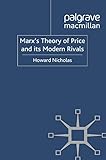Marxs theory of price and its modern rivals Nicholas Howard
Publication details: London Palgrave Macmillan 2011Description: 217P ix PBISBN:- 9781349337613
- 335.412 NIC
| Item type | Current library | Collection | Shelving location | Call number | Status | Date due | Barcode |
|---|---|---|---|---|---|---|---|
 BOOKs
BOOKs
|
National Law School | MPP SECTIO | MPP Section | 335.412 NIC (Browse shelf(Opens below)) | Available | 35251 |
Browsing National Law School shelves, Shelving location: MPP Section Close shelf browser (Hides shelf browser)

|

|

|

|

|

|

|
||
| 333.91 FEL Water | 333.913 STO Canal irrigation in British India | 333.9539 BOR The politics of biofuels, land and agrarian change | 335.412 NIC Marxs theory of price and its modern rivals | 335.412 RUC Development and globalization | 336.001 MAR Coercion and social welfare in public finance | 336.200973 MUR The myth of ownership |
Marxian Economics
Microeconomics
Prices
Contents
Preface ix
Chapter 1 Introduction 1
Chapter 2 Marx’s Theory of Price in the Simple 7 Circulation of Commodities
2.1 Why Marx begins with the simple circulation 7 of commodities
2.2 Understanding the simple commodity circulation 7 process
2.3 Understanding price in simple commodity 9 production
2.4 The magnitudes of reproduction prices 12 Why start with reproduction prices? 12
Relative reproduction prices 13 Money reproduction prices 16
2.5 Actual prices 22 Actual prices and reproduction prices 22 Possibility of divergences 24
Sources of divergences 24 The price adjustment process 25
2.6 A digression on social and abstract labour 26
Chapter 3 Marx’s Theory of Price – Capitalist Commodity 29 Production
3.1 Understanding prices in capitalism 29
3.2 Marx’s approach to explaining the magnitudes of 31 prices in capitalism
3.3 The magnitudes of ‘prices of production’ 34 Relative prices of production 34 Marx’s transformation procedure 39 Supply and demand 40 Money prices of production 41
3.4 Changes in prices of production 44 Relative prices of production 44 Money prices of production 45
3.5 Prices of production with non-producible inputs 47
3.6 Monopoly prices 50 v
3.7 Market prices 52 Possibility of divergences 52 Nature of divergences 53 Causes of divergences 54
The price adjustment process 54
Chapter 4 Marx on Smith and Ricardo 61
4.1 Adam Smith 61
4.2 Ricardo 64
Chapter 5 Marxist Interpretations of Marx’s Theory 70 of Price
5.1 Traditional interpretation 70
Marx’s ‘transformation problem’ 71 Monopoly capitalism 74
5.2 Modern interpretations 77 The New Interpretation 77 The Temporal Single System Interpretation 83
Chapter 6 The Neoclassical Theory of Price 88
6.1 Introduction 88
6.2 The exchange process 89
6.3 Understanding price 92 The pre-condition for the existence of prices 92 Formation of prices 92
Form of prices 95 Purpose of prices 96 Nature of prices 97 Relative prices 97 Money prices 98
6.4 Price constructs 99 Equilibrium prices 99 Long- and short-run prices 101 Competitive and monopoly prices 102 Relative and money prices 104
6.5 The magnitude of equilibrium relative price 105
6.6 Changes in equilibrium relative price magnitudes 107
6.7 The magnitude of monopoly price 108
6.8 The value of money and equilibrium money price 110 level
6.9 The price adjustment process 113 Relative prices 113 Money prices 116 vi Contents
Chapter 7 The Post Keynesian Theory of Price 119 7.1 Introduction 119
7.2 Focus and method 121
7.3 The exchange process 122
7.4 Understanding price 123 The pre-condition for the existence of price 123 Formation of prices 124
Form of prices 126 Purpose of prices 126 Nature of prices 128
7.5 Explicit and implicit price constructs 130 Disequilibrium prices 130 Long- and short-run prices 131
Competitive and non-competitive prices 132 Relative and money prices 134
7.6 The magnitude of price 134
7.7 Changes in price magnitudes 136
7.8 The value of money and the aggregate money 138 price level
7.9 The price adjustment process 140
Chapter 8 Sraffa’s Theory of Price 142
8.1 Focus, method and approach 143
8.2 The exchange process 148
8.3 Understanding price 149 Formation of prices 149 Form of prices 153 Purpose of prices 153
Nature of prices 155
8.4 Implicit price constructs 157 Equilibrium and long-run prices 158
Competitive and non-competitive prices 159 Relative and money prices 161
8.5 The magnitude of relative price 161 Subsistence production 161 Surplus production 164 Single-product industries 164 Joint-product industries 166 Fixed capital 168
Non-produced inputs 170 Contents vii
8.6 Changes in relative price magnitudes 172 The core arguments 172 Extensions 175 Joint products 175 Non-produced inputs 176
8.7 The magnitudes of money prices 176
Chapter 9 Concluding Remarks 178
9.1 Marx’s contribution to the theory of price, or 178 why choose Marx?
9.2 Locating Marx’s theory of price 183
9.3 The significance of rehabilitating Marx’s theory 184 of price Notes 186
References 199
Author Index 209
Subject Index 212

There are no comments on this title.